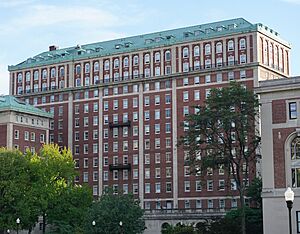John Jay Hall facts for kids
John Jay Hall is a tall building with 15 floors. It's part of Columbia University in New York City. You can find it in the Morningside Heights area.
The building is named after John Jay, one of America's Founding Fathers. He was also the first Chief Justice of the United States Supreme Court. This building was designed by a famous architecture company, McKim, Mead & White. It was built between 1925 and 1929.
John Jay Hall is a home for first-year students from Columbia College and the Fu Foundation School of Engineering and Applied Science. It also has the main dining hall for students, called John Jay Dining Hall. There's also a quick-service restaurant called JJ's Place. The university's health center is here too.
Unlike some other dorms, most rooms in John Jay Hall are for one person. There are usually three double rooms (for two people) on each floor. Other dorms like Wallach and Hartley Halls house students of all ages.
Students living in John Jay Hall can enjoy large lounges on each floor. These lounges have big TVs and comfy chairs. They are great places to hang out, play games, watch movies, or even do homework. The lounges also have microwaves. Residents also have private bathrooms, each with a shower, sink, and toilet.
The two elevators in John Jay Hall are known for being very slow. One elevator goes up to the 13th floor, and the other goes up to the 14th floor. The top floor, the 15th, has no elevator access. The main lounge in the dorm was recently updated. It has a grand piano and old, dark wood walls.
Contents
History of John Jay Hall
Why John Jay Hall Was Built
After World War I, many more students wanted to attend Columbia University. Rent in New York City was also very high. Because of this, Columbia needed to build new dorms. John Jay Hall was built to be much taller than older dorms. It almost doubled their height.
John Jay Hall was different from other buildings built around the same time. Other dorms for women students had lighter wood and a more "homey" style. John Jay Hall, however, had dark wood and was designed to look more "masculine."
In 1919, the university president, Nicholas Murray Butler, said that the new dorm would help student life. It would provide space for student groups. The building was first called Students Hall. It had a dining hall and a student club space on the fourth floor. This helped create a lively student community.
John Jay Hall quickly became a hub for student life. It housed offices for campus newspapers like the Jester and the Columbia Daily Spectator. A famous writer, Thomas Merton, described the fourth floor as "the noisiest and most agitated part of campus." John Jay also hosted dances, alumni events, and holiday parties.
The "Skyscraper Dorm" Elevators
The first students to live in John Jay Hall were not happy with the elevators. The New York Times even called it the "Skyscraper Dorm." Students complained about how slow the elevators were. One piece of graffiti on an elevator said someone "dropped dead from old age waiting for this elevator." Even today, the elevators can still be slow.
John Jay Hall During World War II
During World War II, John Jay Hall was used by U.S. Navy midshipmen. It was run like a naval ship for training. They even called it the "U.S.S. John Jay." When a midshipman wanted to enter the building, they had to say, "request your permission to come aboard, sir."
Student Protests in 1967
In 1967, John Jay Hall was the site of a protest against the Vietnam War. Over 300 students, led by Ted Gold from the SDS group, entered the lobby. They were protesting the U.S. Marines who were recruiting there.
After some conflict, the students left. A professor encouraged them to return to keep their group's reputation. Because of this event, University President Grayson L. Kirk made a new rule. He said that "Picketing or demonstrations may not be conducted within any University Building." The events in John Jay Hall were an early sign of bigger protests that happened at Columbia in 1968.
Images for kids




